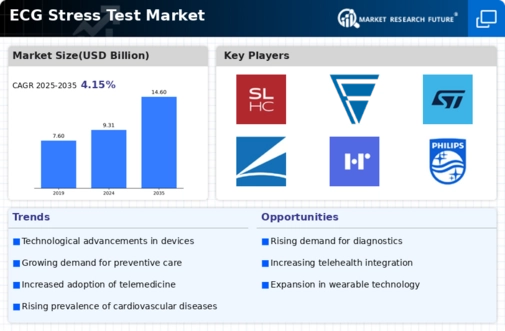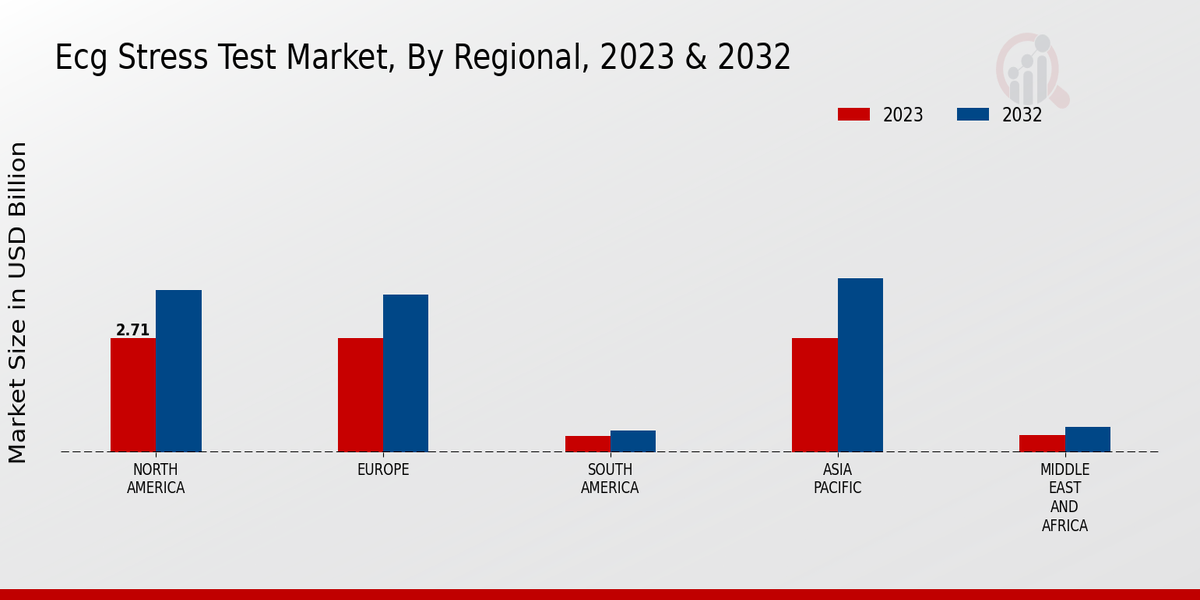Government Initiatives and Funding
Government initiatives and funding aimed at improving healthcare infrastructure are playing a crucial role in the ECG Stress Test Market. Many countries are investing in healthcare programs that prioritize cardiovascular health, recognizing the burden of heart diseases on public health systems. These initiatives often include funding for advanced diagnostic tools, including ECG stress testing equipment. As governments allocate resources to enhance healthcare access and quality, the demand for ECG stress tests is expected to rise. Additionally, public health campaigns promoting heart health and regular screenings are likely to further stimulate interest in ECG stress tests. Market projections suggest that as government support continues, the ECG Stress Test Market will experience sustained growth, driven by increased availability and affordability of testing services.
Integration of Telehealth Services
The integration of telehealth services is emerging as a transformative driver for the ECG Stress Test Market. With the increasing adoption of telemedicine, healthcare providers are now able to offer remote ECG stress testing, allowing patients to undergo assessments from the comfort of their homes. This shift not only enhances patient convenience but also addresses barriers such as transportation and accessibility. Market data indicates that telehealth services have seen exponential growth, particularly in cardiology, where remote monitoring and consultations are becoming standard practice. As telehealth continues to evolve, the ECG Stress Test Market is likely to benefit from the expanded reach and flexibility that these services provide. This trend may lead to increased patient engagement and adherence to testing protocols, ultimately improving cardiovascular health outcomes.
Technological Innovations in ECG Devices
Technological advancements in ECG devices are significantly influencing the ECG Stress Test Market. Innovations such as portable ECG monitors and advanced software algorithms have improved the efficiency and accuracy of stress testing. These devices enable healthcare professionals to conduct tests in various settings, including outpatient clinics and home environments, thereby expanding access to cardiac assessments. The introduction of wireless and mobile ECG devices has further enhanced patient convenience and compliance. Market data indicates that the adoption of these innovative technologies is projected to increase, as they offer real-time monitoring and data analysis capabilities. This shift towards more sophisticated ECG solutions is likely to drive the growth of the ECG Stress Test Market, as healthcare providers seek to leverage technology to improve patient outcomes and streamline diagnostic processes.
Rising Awareness of Preventive Healthcare
The increasing awareness of preventive healthcare is a significant factor propelling the ECG Stress Test Market. As individuals become more informed about the importance of early detection of health issues, there is a growing inclination towards regular health screenings, including ECG stress tests. This trend is particularly evident among populations at risk for cardiovascular diseases, where proactive measures are essential. Educational campaigns and health initiatives aimed at promoting heart health have contributed to this heightened awareness. Market analysis suggests that as more people prioritize preventive care, the demand for ECG stress tests will likely rise, leading to an expansion of the ECG Stress Test Market. Healthcare providers are responding to this trend by offering comprehensive screening packages that include stress testing, further solidifying the role of ECG tests in preventive healthcare strategies.
Growing Prevalence of Cardiovascular Diseases
The rising incidence of cardiovascular diseases is a primary driver for the ECG Stress Test Market. As heart-related ailments continue to escalate, healthcare providers are increasingly adopting ECG stress tests as a preventive measure. According to recent statistics, cardiovascular diseases account for a substantial percentage of global mortality rates, prompting a heightened focus on early detection and management. This trend is likely to bolster the demand for ECG stress tests, as they play a crucial role in assessing cardiac function under stress conditions. Furthermore, the integration of advanced technologies in these tests enhances their accuracy and reliability, making them indispensable in modern healthcare settings. Consequently, the ECG Stress Test Market is expected to witness significant growth as healthcare systems prioritize cardiovascular health and invest in diagnostic tools that facilitate timely interventions.




















Leave a Comment